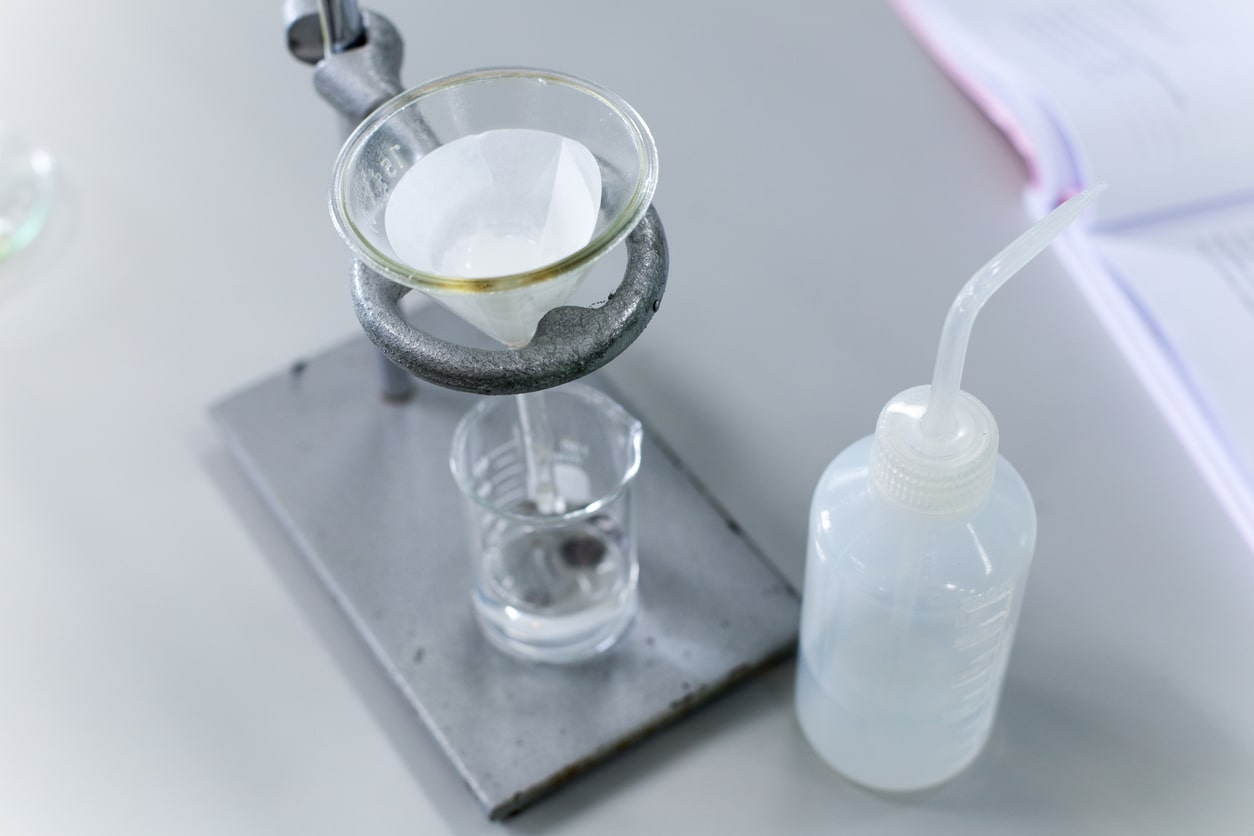Recrystallization is the process of obtaining pure crystals from a compound containing impurities in a solvent. Hot gravity filtration is a process commonly used to remove these impurities from a solution prior to recrystallization.
Hot filtration is a type of filtration where the filtration equipment and the sample are heated during the process. Hot filtration is needed for recrystallization when impurities exist in solution. Recrystallization requires a hot solution because the solution needs to be supersaturated for crystals to form on cooling. Hot solutions can hold more solute in suspension compared to a cold solution because the solubility of most solids increases with a rise in temperature. This means that a saturated solution will contain more dissolved solute if prepared at a higher temperature than at a cold temperature. When the hot solution then cools, it will be supersaturated – it will hold more dissolved solute than its cold equivalent would.
The impurity may have a different solubility than the compound in certain solvents. The aim is to choose a solvent that dissolves the compound when heated, but that doesn’t dissolve the impurity at high temperatures. The impurity is then filtered out during the hot gravity filtration process.
Hot gravity filtration: how to do it
Hot gravity filtration requires an Erlenmeyer flask, a stemless funnel, filter paper, and a hot plate. The flask and funnel need to be stabilized and held in place by clamps to prevent the equipment from tipping over.
Using a stemless funnel helps to prevent crystals forming on the paper. Because a funnel’s stem is very small, the solution will cool rapidly while moving through it, potentially causing unwanted crystallization within the stem that could clog up the filtration system.
Folding the filter paper into a fluted shape increases the filtration rate. This prevents it from sticking to the sides of the funnel, causing pressure to build up underneath and reducing the filtration efficiency.
Hot gravity filtration: step by step process
- Fold the filter paper into a fluted shape by first folding it in half, and then into quarters. Continue by folding in between the previous fold. Do this twice, and then repeat the process on the other side of the paper.
- Some solutions will crystallize immediately upon touching the room-temperature filter paper. This problem can be avoided by heating the whole assembly before pouring the hot solution into it.
- Heat the solution on a hot plate and gradually pour it into the filter-lined funnel, adding a small amount at a time.
- When the whole system is working properly, the solution with the dissolved compound will move through the filter and into the Erlenmeyer flask, while the insoluble impurities are left behind on the filter paper.
- Allow filtrate to cool to room temperature or below. After the hot gravity filtration process is complete, crystals will start to come out of solution and grow larger as the filtrate in the flask slowly cools.
- Once cooled, the crystals can be collected via vacuum filtration.
Vacuum filtration is used to collect crystals
Once you have completed your recrystallization and your filtrate has cooled to room temperature, you can use the vacuum filtration process to collect the crystals.
Vacuum filtration uses a vacuum to help rapidly pull the solution through the filter and is therefore faster than gravity filtration. To carry out a vacuum filtration, you will need a Büchner funnel to collect the crystals while the solution is pulled out by the vacuum.
Vacuum filtration: step by step process
- Using a flask with a Büchner funnel inserted, add a piece of filter paper in the base of the funnel. It should cover all of the holes in the filter.
- Connect the flask to a vacuum source with a length of tubing.
- Seal the filter paper to the funnel by wetting it with a small number of solvent drops. Use the same solvent that you will use for the filtration.
- Turn on the vacuum pump (or other vacuum source) and connect it to the flask using the tube. Ensure the flask is sealed.
- Pour the filtrate containing the crystals into the middle of the filter paper, adding it bit by bit. The vacuum should pull the liquid through the funnel, while the crystals remain on the paper.
- Remove the tubing from the flask. If you are using a water aspirator, take the tubing off the flask before you turn the tap off, to prevent water being sucked back into the flask.
- Take the filter paper with the crystal solids out of the funnel.
- Once you have the separated product, the crystals need to be dried. Usually, air drying is the best option. You can also dry the crystals to a certain extent by maintaining the vacuum after the solution has been pulled out. Much of the remaining solvent can be removed from the crystals this way. Alternatively, you could use a vacuum desiccator to fully dry the crystals.
Hot gravity filtration has many uses beyond recrystallization procedures. It can be used in any situation where impurities need to be removed from solution, and where a solvent can be chosen that will dissolve one compound at high temperatures but will not dissolve the other compound. Solubility tables are very useful for choosing an appropriate solvent for this purpose.





